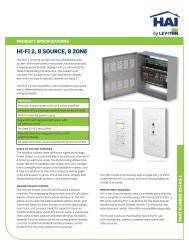Model 29A00 Thermostat Isolation Module - Home Automation, Inc.
Model 29A00 Thermostat Isolation Module - Home Automation, Inc.
Model 29A00 Thermostat Isolation Module - Home Automation, Inc.
You also want an ePaper? Increase the reach of your titles
YUMPU automatically turns print PDFs into web optimized ePapers that Google loves.
<strong>Model</strong> <strong>29A00</strong> <strong>Thermostat</strong> <strong>Isolation</strong> <strong>Module</strong><br />
DESCRIPTION<br />
The HAI <strong>Model</strong> <strong>29A00</strong> <strong>Thermostat</strong> <strong>Isolation</strong> <strong>Module</strong> (TIM) is designed to isolate an HAI <strong>Model</strong> RC-80 series (Rc-8x) thermostat<br />
from the heating and cooling system it is controlling. This module is used when there is an incompatibility between the RC-8x<br />
thermostat and the controlled HVAC system. Since the RC-8x is a “power stealing” thermostat, there must be sufficient current<br />
available in the unused circuit (i.e. the heating circuit if the thermostat is calling for cooling) to drive the thermostat electronics. The<br />
RC-8x draws very little current, about 10 mA on average. However, it requires an uninterrupted power supply. Even a momentary<br />
interruption in power to the RC-8x will cause it to reset (showing all segments of the display and resetting the power on delay timer).<br />
Most heating and cooling systems are designed with power stealing thermostats in mind, and are fully compatible with the RC-8x<br />
without the TIM. In the case of incompatibility, the TIM assures a continuous and adequate supply of current to the RC-8x, while<br />
eliminating any current draw from the heating and cooling system. The TIM also makes the RC-8x compatible with systems using<br />
voltages other than 24 VAC, such as millivolt systems or DC controlled systems.<br />
This module can also be used when the heating and cooling system has separate transformers. RH is for heating and RC is for<br />
cooling. These terminals are isolated from each other on this module.<br />
The TIM should be used when the following conditions apply:<br />
1. The RC-8x “resets” (as evidenced by all segments on the display illuminating for several seconds) when calling for heat or cool.<br />
2. The RC-8x is used to control millivolt heating systems or other systems, which do not use 24 volts AC for the thermostat circuit.<br />
3. The RC-8x is used to control heating and cooling systems with separate transformers.<br />
The TIM is mounted on or near the heating and cooling equipment. Only 4 conductors are used to the RC-8x: R, G, W and Y. The C<br />
(common) terminal on the RC-8x is not used. The LED indicators on the TIM will indicate which circuits are energized: FAN (G<br />
terminal), HEAT (W terminal), and COOL (Y terminal).<br />
INSTALLATION<br />
1. Locate an area on the panel of the HVAC system large enough to mount the <strong>Model</strong> <strong>29A00</strong>. The area should be free of<br />
obstructions both on the front and back of the panel.<br />
2. Place the <strong>Model</strong> <strong>29A00</strong> against the panel and mark the center of the four mounting holes with a pencil.<br />
3. Drill a 3/16” diameter hole in each location marked.<br />
4. Insert the large end of the 3/8” long nylon standoff into each of the holes drilled as shown in Figure 1.<br />
THERMOSTAT ISOLATION MODULE PCA<br />
3/8" NYLON STANDOFF 3/8" NYLON STANDOFF<br />
PANEL<br />
Figure 1 - Mounting the <strong>Model</strong> <strong>29A00</strong><br />
<strong>Home</strong> <strong>Automation</strong>, <strong>Inc</strong>.
5. Attach the <strong>Model</strong> <strong>29A00</strong> onto the ends of the four standoffs. They should snap into the holes on the <strong>Model</strong> <strong>29A00</strong> PCA.<br />
6. Wire the <strong>Model</strong> <strong>29A00</strong> according to Figure 2 or Figure 3 depending on the type of HVAC System.<br />
RED(HOT)<br />
GREEN(FAN)<br />
YELLOW(COOL)<br />
WHITE(HEAT)<br />
GREEN(FAN)<br />
YELLOW(COOL)<br />
JUMPER<br />
RED(HOT)<br />
WHITE(HEAT)<br />
HVAC SYSTEM<br />
R(HOT)<br />
G(FAN)<br />
Y(COOL)<br />
W(HEAT)<br />
R(HOT)<br />
G(FAN)<br />
RED(HOT)<br />
GREEN(FAN)<br />
RC80 THERMOSTAT<br />
Y(COOL)<br />
W(HEAT)<br />
YELLOW(COOL)<br />
WHITE(HEAT)<br />
POWER<br />
TRANSFORMER<br />
24 VAC / 5-20 VA<br />
Figure 2 - Connections to Isolate <strong>Thermostat</strong> from HVAC System<br />
Page 2
RED(HOT)<br />
GREEN(FAN)<br />
YELLOW(COOL)<br />
WHITE(HEAT)<br />
GREEN(FAN)<br />
YELLOW(COOL)<br />
REDc(HOT)<br />
REDh(HOT)<br />
WHITE(HEAT)<br />
COOLING SYSTEM<br />
R(HOT)<br />
G(FAN)<br />
Y(COOL)<br />
W(HEAT)<br />
R(HOT)<br />
G(FAN)<br />
Y(COOL)<br />
RED(HOT)<br />
GREEN(FAN)<br />
YELLOW(COOL)<br />
RC80 THERMOSTAT<br />
HEATING SYSTEM<br />
POWER<br />
TRANSFORMER<br />
24 VAC / 5-20 VA<br />
R(HOT)<br />
W(HEAT)<br />
RED(HOT)<br />
WHITE(HEAT)<br />
Figure 3 - Connections to Heating and Cooling Systems with Separate Transformers<br />
Page 3












